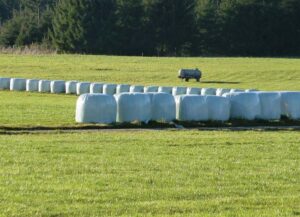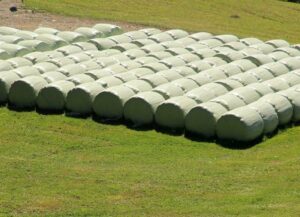Alvaro Garcia
Orchardgrass (Dactylis glomerata) is a common, very productive cool-season bunchgrass species, fairly drought resistant, originally native to Europe and North Africa. It is currently widely used for hay and pasture worldwide because of its high yield and sugar content, which makes it very palatable for cattle. Previous studies noted that orchardgrass had greater nutritive value than other grasses commonly used as feedstuff for cattle, such as bromegrass, tall fescue, and reed canarygrass.
There is a limit however to how much can be included in a diet to avoid negative effects on rumen fermentation. Past research has suggested that this limit may be at approximately at 60–75% of the diet. Among its virtues are that it is easily established where there is adequate moisture and moderate temperatures, which has made it popular to inter-seed with alfalfa. There are many varieties to choose from with early and late maturing characteristics and a 10-20 days spread in heading date between them. It is important then to choose a late maturing variety since once alfalfa is ready to harvest, orchardgrass may have passed its optimum harvest point.
An article published recently described the rumen fermentation characteristics of orchardgrass and alfalfa preserved as hay or silage blended at different proportions. Second cutting orchardgrass and alfalfa were harvested at the jointing and early bloom stages, respectively. Once harvested, 20 kg-samples of each forage were divided equally in two subsamples. The first subsample of each forage was field wilted (48h), oven-dried (48 h, 65 °C), and then blended at 100:0, 75:25, 50:50, 25:75, and 0:100 (orchardgrass/alfalfa, w/w). The second subsample of each forage was field wilted for 2 h to reach 40% dry matter (DM), then chopped to 2.5 cm to be ensiled. This second wilted forage samples were mixed at DM ratios of 100:0, 75:25, 50:50, 25:75, and 0:100 (orchardgrass: alfalfa, w/w) and packed to 750 g weight in polyethylene silos (1 L capacity). There were 5 micro silo replicates of each forage sealed with screw lids, that were kept in the dark at approximately 25◦C. After 40 days, the samples were analyzed for pH, ammonia N, and organic acids, including lactic acid, acetic acid, propionic acid, and butyric acid. Rumen fermentation parameters were also analyzed.
Table 1. Chemical composition of forages prior to hay making and ensiling
| Item (% DM) | Orchardgrass | Alfalfa |
| Dry matter | 26.0 | 26.8 |
| Crude protein | 16.7 | 21.4 |
| Neutral detergent fiber | 56.2 | 48.4 |
| Acid detergent fiber | 42.4 | 38.5 |
| Acid detergent lignin | 3.7 | 7.2 |
| Ash | 11.1 | 9.2 |
| Ether extract | 2.7 | 2.4 |
| Calcium | 0.70 | 1.4 |
| Phosphorous | 0.34 | 0.34 |
| Potassium | 3.36 | 2.8 |
| Magnesium | 0.37 | 0.2 |
As could be expected increasing alfalfa in the blends led to higher contents of protein, lignin, and calcium and decreased fiber (NDF, ADF), ash, and magnesium both in hay and silage blends. Protein and fiber contents were greater in hay compared to silage blends.
As alfalfa increased in the silage mixtures, pH and concentrations of ammonia N and acetic acid increased, whereas the concentration of lactic acid decreased. The concentration of ammonia nitrogen in alfalfa was approximately twice that of orchardgrass. No effects of alfalfa inclusion on the proportions of acetate, propionate, butyrate, and iso-butyrate were observed in the rumen. However, the concentrations of total volatile fatty acids (VFAs), valerate and isovalerate increased linearly as alfalfa increased in the blends.
The 50:50 ratio of orchardgrass and alfalfa both in hay and silage blends improved rumen microorganism growth, nutrient digestion, and ruminal fermentability. Increments of rumen degradability and methane production were greater for the silage than hay blends. The relative forage quality (RFQ) value was greatest at 75:25 orchardgrass to alfalfa hay and silage blends. Increasing the proportion of alfalfa increased total digestibility but decreased fiber digestibility. The greatest digestibility values were observed for the 50:50 blends both for hay and silage.
No differences were observed in digestibility for either hay or silage mixtures containing 50, 75, or 100% alfalfa, however, all mixtures at these proportions had greater overall digestibility and reduced fiber digestibility than did mixtures with 25% or 0% alfalfa. If the DM and organic matter digestibility of a blend needs to be increased to improve animal performance, at least 50% alfalfa is required based on these results.
Reference
Xue, Zhulin & Liu, Nan & Wang, Yanlu & Yang, Hongjian & Wei, Yuqi & Moriel, Philipe & Palmer, Elizabeth & Zhang, Yingjun. (2019). Combining Orchardgrass and Alfalfa: Effects of Forage Ratios on In Vitro Rumen Degradation and Fermentation Characteristics of Silage Compared with Hay. Animals. 10. 59. 10.3390/ani10010059.
© 2020 Dairy Knowledge Center, LLC. All Rights Reserved.









